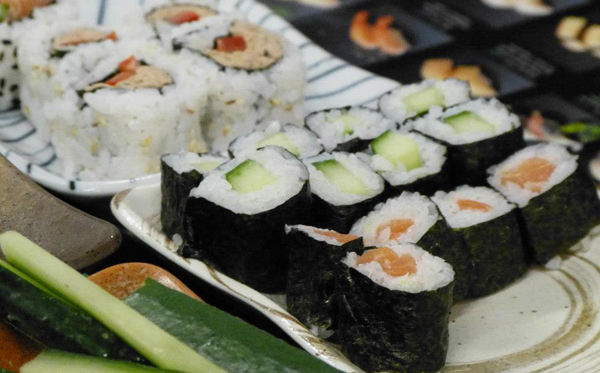
 Japanese sushi chefs study for ten years. What could Jayne Dwyer learn in two hours? Quite a lot, as it turned out…
Japanese sushi chefs study for ten years. What could Jayne Dwyer learn in two hours? Quite a lot, as it turned out…
How much can you learn about sushi in a two hour Introduction To Sushi Class? Well, quite a lot actually.
Despite the fact that to become a sushi chef in Japan your apprenticeship lasts a decade, you can learn to roll and make sushi in the class at York Cookery School and it will surpass the extravagant little boxes you buy in your supermarket.
Before our class started, the early birds were shown how to prepare a cucumber for sushi (cutting it to size and de-seeding it to reduce its moisture content) and we were given the tip of the day: “buy straight cucumbers”.
Our chef Simon Phillips explained that on a two-hour session, it is necessary to do some of the preparation before the session, and that cooking the sushi rice is an art in itself in Japan.
If you enrol onto a full day course, the morning focuses on the preparation of the rice, which is sticky enough to hold its shape, whilst each grain somehow keeps its own identity, and then you roll in the afternoon.
Friendly classmates
When I arrived for the introductory course, the kitchen was adorned with exciting little bowls of rice, already flavoured with rice vinegar, salt and sugar; pretty plates of fresh vegetables and a selection of fish.
I am a bit of a sushi fiend and when we were asked if we had made sushi before, I didn’t like to admit that I bought a sushi mat several years ago and that had only used it once (a bit like my yoga mat). I was pleased to find myself in a room full of friendly novices.
My fellow “sushi rollers” for the day included Laura Collier and her husband David, who were enticed onto the course after attending the open day (the Cookery School opened in January.) I also met David and Jonathan, stepfather and stepson with a combined love of Japan and cookery and who had come across the course on the internet, looking for something to do.

The session started with a welcoming chat and a demonstration from Simon. We were shown how to gently spread out the rice onto the seaweed and, whilst anything goes in terms of what fillings can be added, we were shown fillings that would work well because the sushi benefits from a soft filling which will bind and hold the other ingredients.
We learnt how to make my personal favourite, Californian Rolls, which Simon explained were developed as a ploy to encourage Americans to embrace sushi. When sushi gained popularity in the Sixties and Seventies apparently the Americans, were not enamoured by the thought of eating seaweed (nori) and raw fish.
The seaweed is an essential ingredient, but is cleverly hidden on the inside of this particular sushi. It is also laced with cream cheese, known to be a favoured ingredient.
Marvellous morsels
Making our own sushi, it was not difficult to see why the Japanese have a ten-year apprenticeship. With beautifully fresh and vibrant ingredients it was relatively easy to produce some wonderful little morsels that tasted absolutely delicious, but what impressed me was how therapeutic it was.
I could have spent all day gently pressing the little grains onto the seaweed and decorating Californian Rolls with toasted sesame.
By the end of the session, everybody had successfully made four sushi rolls, which we cut, tasted and packed up to share with family. The course itself cost a very reasonable £25; as well as learning enough to make me want to learn some more (which is always a good sign) I went home with enough food to feast on for the rest of the day.
- Introduction To Sushi is only one of a range of courses by York Cookery School, which cover making everything from Thai street food to French pastries
- For more details these and other courses including ones for children and teenagers visit the York Cookery School website
- To email the school click here, or ring 01904 500700
.
